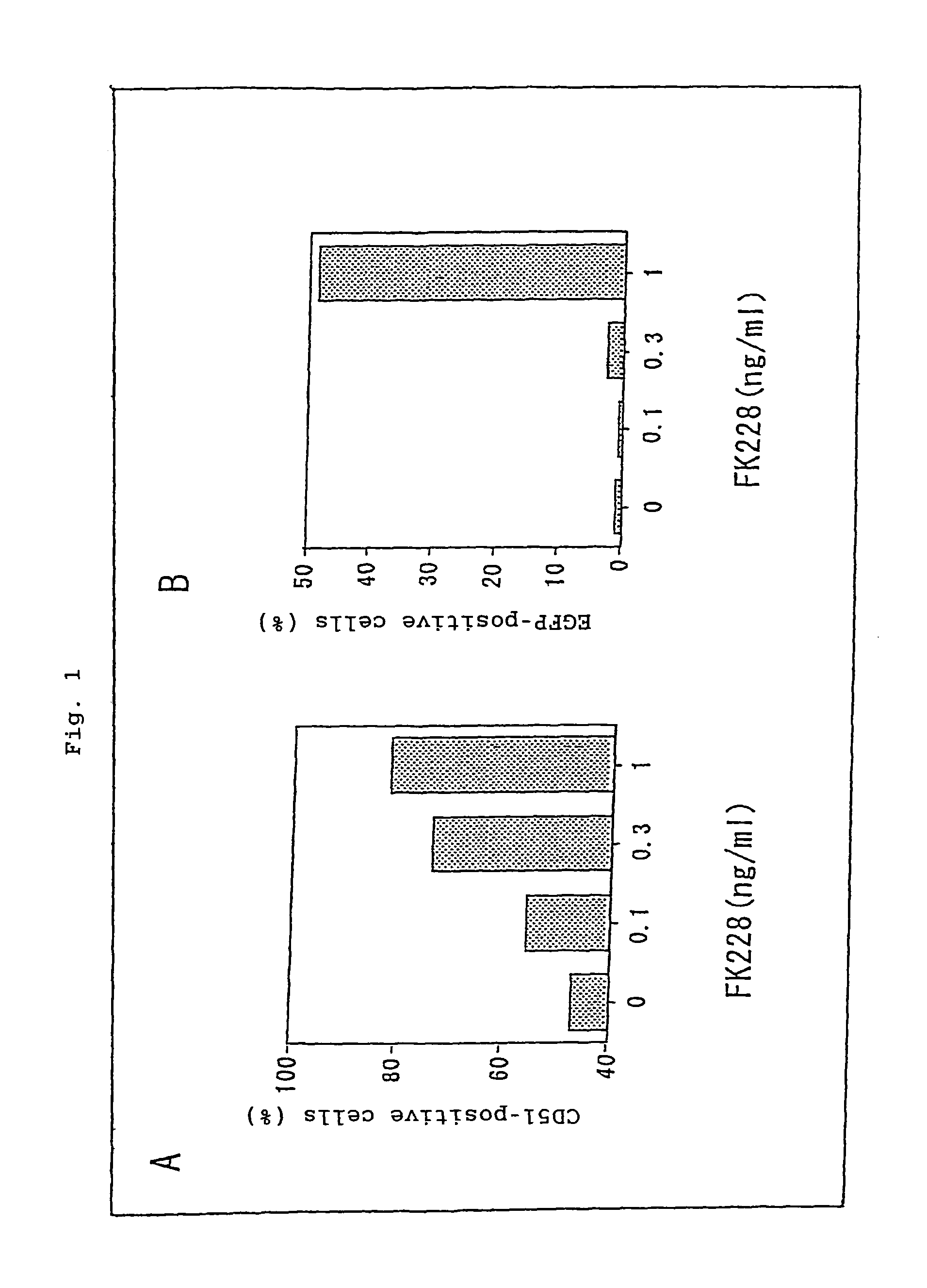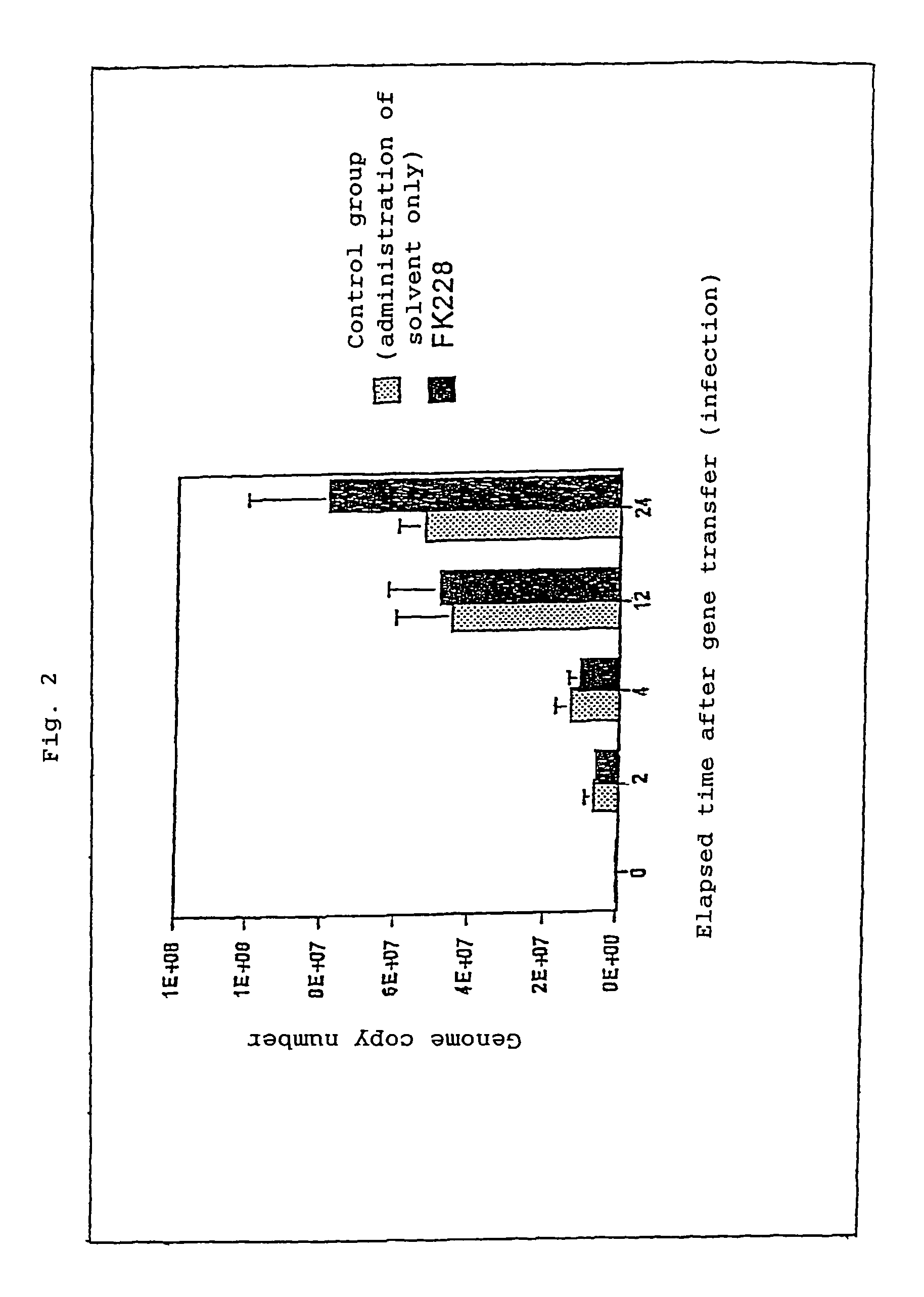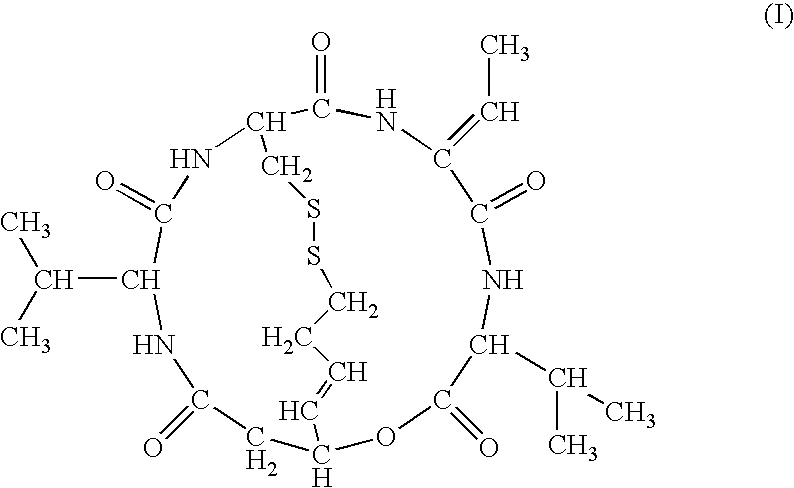Gene introduction efficiency enhancer
a technology of gene introduction and efficiency enhancement, applied in the direction of chemical treatment enzyme inactivation, peptides, drug compositions, etc., can solve the problems of low gene transfer efficiency of aav vectors, less interest in cancer therapy, liver or brain inflammation, etc., to increase the gene transfer efficiency and low gene transfer efficiency.
- Summary
- Abstract
- Description
- Claims
- Application Information
AI Technical Summary
Benefits of technology
Problems solved by technology
Method used
Image
Examples
example 1
Effect of FK228 on the Efficiency of AAV-Vector-Mediated Gene Transfer
The effect of FK228 on enhancing expression of a transgene was evaluated with glioma cells. Type-2 AAV vector (1×104 genome copies / cell) and FK228 (0, 0.01, 0.1, 1, 10, or 100 ng / mL) were added to a culture supernatant of the human glioma cell line U251MG, and 24 hours later, expression of EGFP was observed under a fluorescence microscope. Through this observation, expression of EGFP was found to be enhanced in an FK228-dose-dependent manner. Particularly when added at a concentration of 1 ng / mL or more, FK228 exhibited remarkable EGFP expression enhancing effect.
The fact that the enhancer of the present invention exhibited gene expression enhancing effect within 24 hours after gene transfer (infection) suggests the possibility that the episomal AAV genome which had not undergone chromosomal integration underwent histone modification, whereby its gene expression was regulated and enhanced.
Similar to the case of U2...
example 2
Relation Between the Effect of FK228 on Increasing Gene Transfer Efficiency and Integrin Expression
The gene expression enhancing effect obtained by employment of an adenovirus vector in combination with a histone deacetylase inhibitor is considered to be based on the mechanism that expression of a receptor such as integrin is enhanced by the histone deacetylase inhibitor. Tests were performed to assess whether or not such a mechanism is involved in the effects of the present invention.
Type-2 AAV vector (1×104 genome copies / cell) and FK228 (0, 0.01, 0.1, or 1 ng / mL) were added to a culture supernatant of U251MG, and 24 hours later, the percent occurrence of cells positive for CD51 (integrin) or EGFP was calculated through FACS analysis. The FACS analysis was performed through a customary method by use of FACSCan (Becton Dickinson, San Jose, Calif.) and CellQuest software (Becton Dickinson, San Jose, Calif.).
PE-labeled anti-CD51 monoclonal antibody: 13C2 was obtained from Cymbus Biote...
example 3
Effect of FK228 Addition on the Number of Viral Genome Copies Taken into Cells
Type-2 AAV vector (1×104 genome copies / cell) and FK228 (1 ng / mL) were added to a culture supernatant of U251MG, and the number of viral genome copies taken into cells was semi-quantified by means of real-time PCR (ABI, Prism 7700; QIAGEN, SYBR Green PCR kit QuantiTect) (performed through the method according to Mol. Ther. Aug. 6, 2002 (2): 272-278). After U251MG cells were infected with the type-2 AAV vector, the number of intracellular genome copies was measured in a time-course manner (0, 2, 4, 12, and 24 hours). No significant difference was observed in the genome copy number between an FK228-treated group and a control group (only a solvent), although a slight increase in the genome copy number was observed in the FK228-treated group 24 hours after the infection. The results are shown in FIG. 2.
The results indicate that the effect of FK228 in enhancing transgene expression is not mediated by an increas...
PUM
 Login to View More
Login to View More Abstract
Description
Claims
Application Information
 Login to View More
Login to View More - R&D
- Intellectual Property
- Life Sciences
- Materials
- Tech Scout
- Unparalleled Data Quality
- Higher Quality Content
- 60% Fewer Hallucinations
Browse by: Latest US Patents, China's latest patents, Technical Efficacy Thesaurus, Application Domain, Technology Topic, Popular Technical Reports.
© 2025 PatSnap. All rights reserved.Legal|Privacy policy|Modern Slavery Act Transparency Statement|Sitemap|About US| Contact US: help@patsnap.com



